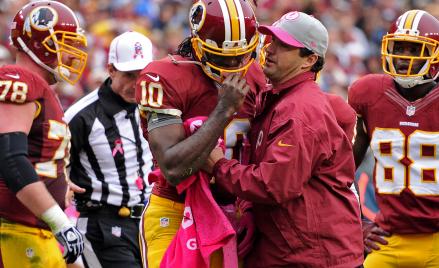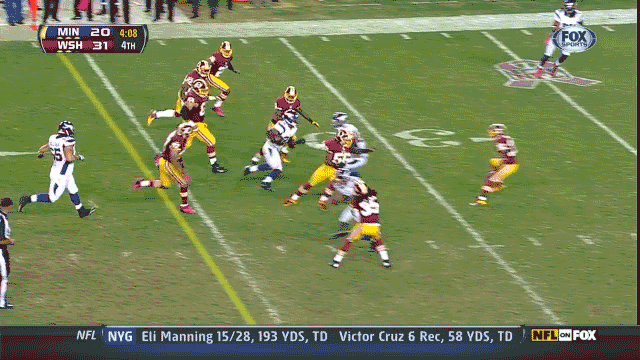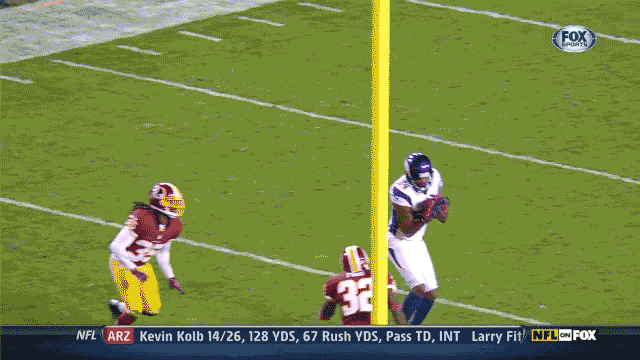NFL 2012
"Shaken up on the play": The semantic loopholes that allow the NFL to survive its concussion crisis.

Photo by Patrick Smith/Getty Images.
Robert Griffin III didn't just run and pass the Washington Redskins to a victory over the Minnesota Vikings on Sunday. He also became the poster boy for NFL player safety. Just a week before, Griffin was on the field face down after being hit by Atlanta Falcons linebacker Sean Weatherspoon. When team doctors discovered that the quarterback couldn't remember the quarter or the score, they diagnosed him with a concussion and forced him to leave the game. Griffin returned to practice after passing his concussion tests and was permitted to play in Week 6 when he was cleared by a team physician and an independent neurologist, as the league's rules require.
This was the NFL's new safety protocol at its best. RG3's nationally televised concussion was diagnosed correctly and handled responsibly. As the NFL Players Association's medical director Thom Mayer explained to me, "They did the right thing medically, and it turns out it was the right thing to do competitively."
That's the narrative the NFL wants us to believe—that there are clear protocols, that these protocols are followed consistently, and that player safety is more important than anything else. The real story is a lot more muddled. While Mayer said it was "a textbook case for how to deal with this, with respect to the protocol," he has also criticized the Redskins for initially saying that RG3 was "shaken up"—a terminological faux pas that could lead the NFL to issue the Redskins a "hefty" fine. As Fox's Jay Glazer reported, the league insists that teams "immediately acknowledge a head injury to prevent concussed players from getting pushed back on field."
But the "shaken up" dodge would be put to use again in that Redskins-Vikings game. With four minutes to go in the fourth quarter, Minnesota's Adrian Peterson ran over Washington safety Jordan Pugh in the open field.

After a commercial break, the Fox broadcast showed Pugh—who had been "shaken up on the field," according to play-by-play man Dick Stockton—walking into the locker room. Just a few minutes of game time later, Pugh was back in the Redskins' secondary. On a short pass intended for Michael Jenkins, Pugh lowered his head and broke up the potential completion. He then crumpled to the ground. This time he would not return.

"Pugh twice has been shaken up in this game," Stockton noted during Fox's slo-mo replay of the hit. The Redskins, though, classified these two shake-ups differently. In the words of coach Mike Shanahan, according to the Fredericksburg, Va., Free Lance-Star, "[Pugh] comes on the sideline and [medical personnel] just told me Jordan's out, and all of a sudden, he's been cleared and he's ready to go. … Then, at the end, they just told me that when he went down, he was dizzy, nauseous. He's out." And this is how the Associated Press described the injuries in its post-game report: "Pugh left the fourth quarter twice with a head injury. The Redskins say he was cleared to return after the first injury, then was diagnosed with a concussion after the second one."
The semantic difference here is crucial. According to the policy the NFL put in place in 2011, players with "concussion-like symptoms" should be "removed from the game and not allowed to return to practice or play until being cleared by an independent neurological consultant." Pro Football Talk also reported last September that in the run-up to the 2011 season, the league notified every team "that there should be absolutely no situation in which a player sets foot on the field after he has suffered a concussion." The PFT post continues:
The memo … also makes clear that if the medical staff thinks a player could have suffered a concussion but hasn't formally diagnosed one, that's enough to take him out of the game.
Under the heading, "WHEN IN DOUBT LEAVE THEM OUT," the memo states: "If you have any suspicion about a player being concussed, remove him from the game. Always err on the side of caution."
Dr. Hunt Batjer and Dr. Richard Ellenbogen, the co-chairs of the league's Head, Neck and Spine Committee, wrote the memo, which also notes that once a player is pulled, he can't go back in until both the team doctor and an independent doctor say he's ready to go.
Given that Pugh suffered a head injury with four minutes to go in the fourth quarter, you'd think he wouldn't have had a chance to get hit in the head again a few minutes later—"when in doubt, leave them out." But as far as the Redskins and the NFL are concerned, a "head injury" is apparently not the same as a "concussion." NFL spokeswoman Clare Graff told me the league "looked into that play and found that all procedures were followed correctly, both with the first hit and the second." When I asked Mayer, the NFLPA's medical director, about Pugh's two injuries, he basically agreed with the league's take. "I don't think the second one was necessarily related to the first," he told me, referring to the first head injury as a "subconcussive blow."
This is the kind of thinking that's necessary to keep the league running each Sunday. If team doctors really did err on the side of caution, sidelining players every time they got jacked up, then there wouldn't be enough guys to suit up by the end of the fourth quarter. Rather than encourage teams to exercise caution, the rules that mandate that concussed players take a seat incentivize fudging—classifying a possible concussion in the loosest possible terms to avoid the scarlet "C" that brands a player as unplayable.
It's the NFL's own rules, then, that encourage the same behavior the league claims it wants to prevent. When Robert Griffin III's health is in peril, fans, the media, and the league office carefully scrutinize whether the rules are being followed. If mistakes are made, the team is criticized. Fines will follow. Jay Glazer reports that the NFL wants "to prevent concussed players from getting pushed back on field." But with regard to a no-name like Jordan Pugh, the Redskins and the NFL are a lot freer to do what they please, using semantics as a shield. Was Pugh shaken up? Did he have a head injury? A concussion? Two concussions? The NFL doesn't have the answers, and it hopes nobody bothers to ask the questions.